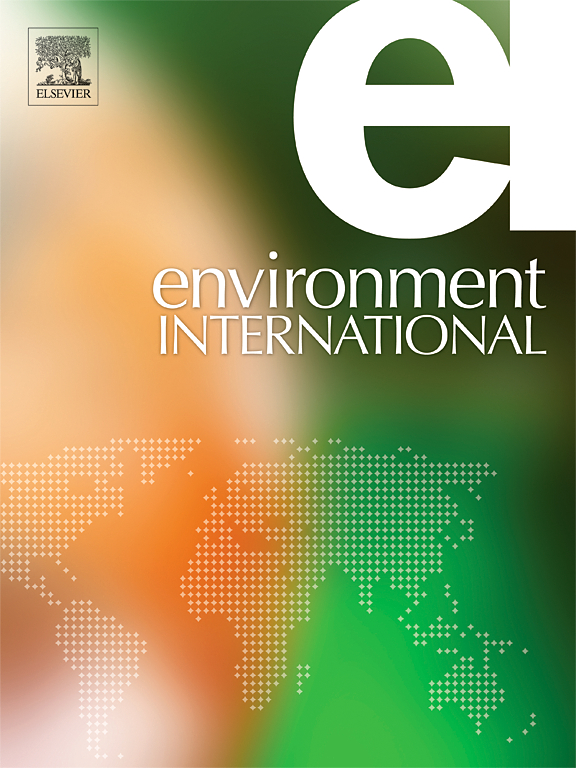产前暴露于全氟烷基和多氟烷基物质与7岁儿童执行功能和行为困难:来自上海出生队列研究的证据
IF 10.3
1区 环境科学与生态学
Q1 ENVIRONMENTAL SCIENCES
引用次数: 0
摘要
全氟和多氟烷基物质(PFAS)是持久性环境污染物。产前暴露在关键发育窗口可能会对胎儿大脑发育产生不利影响。然而,关于产前PFAS暴露对学龄早期行为和执行功能影响的证据仍然不一致,来自高暴露地区的数据特别有限。本研究在前瞻性出生队列中调查了产前PFAS暴露和7岁儿童的神经发育结局。方法本研究分析了上海出生队列的数据,其中包括1543对母子。在妊娠早期收集的母体血浆中检测了10种PFAS化合物。采用执行功能行为评定量表和优势与困难问卷对7岁儿童的神经发育结果进行评估。多变量线性回归、基于分位数的g计算和加权分位数和回归评估了个体和联合效应。进行了性别分层分析和敏感性分析。结果产前PFOA暴露与执行功能障碍(BRI: β = 0.80,95 % CI[0.16, 1.43])和行为问题(总困难:β = 0.56,95 % CI[0.19, 0.93])增加有关。相反,PFUA和PFDA与神经发育评分下降有关。性别分层分析表明,暴露于PFOA和PFHpA的女性预后较差,而暴露于PFNA、PFDA和PFUA的男性预后较好。混合分析没有发现明显的联合效应。敏感性分析证实了研究结果的稳健性。结论中国7岁儿童产前PFAS暴露对执行功能和行为结果具有化合物特异性和性别依赖性的影响。PFOA与较差的表现有关,而PFUA和PFDA呈反比关系,尤其是在男性中。本文章由计算机程序翻译,如有差异,请以英文原文为准。
Prenatal exposure to per- and polyfluoroalkyl substances and childhood executive function and behavioral difficulties at age 7: evidence from the Shanghai birth cohort study
Background
Per- and polyfluoroalkyl substances (PFAS) are persistent environmental contaminants. Prenatal exposure during critical developmental windows may adversely affect fetal brain development. However, evidence on the impact of prenatal PFAS exposure on early school-age behavioral and executive function remains inconsistent, with particularly limited data available from high-exposure regions. This study investigated prenatal PFAS exposure and neurodevelopmental outcomes in 7-year-old children within a prospective birth cohort.
Methods
This study analyzed data from the Shanghai Birth Cohort, which included 1,543 mother-child pairs. Maternal plasma collected during early pregnancy was tested for ten PFAS compounds. Neurodevelopmental outcomes at age 7 were assessed using the Behavior Rating Inventory of Executive Function and the Strengths and Difficulties Questionnaire. Multivariable linear regression, quantile-based g-computation, and weighted quantile sum regression evaluated individual and joint effects. Stratified analyses by sex and sensitivity analyses were conducted.
Results
Prenatal PFOA exposure was associated with increased executive dysfunction (BRI: β = 0.80, 95 % CI [0.16, 1.43]) and behavioral problems (total difficulties: β = 0.56, 95 % CI [0.19, 0.93]). Conversely, PFUA and PFDA were associated with decreased neurodevelopmental scores. Sex-stratified analyses linked PFOA and PFHpA exposure to poorer outcomes in females, while PFNA, PFDA, and PFUA were associated with better outcomes in males. Mixture analyses found no significant joint effects. Sensitivity analyses confirmed the robustness of the findings.
Conclusion
Our study revealed that prenatal PFAS exposure in 7-year-old Chinese children had compound-specific and sex-dependent impacts on executive function and behavioral outcomes. PFOA was associated with poorer performance, while PFUA and PFDA demonstrated inverse relationships, particularly in males.
求助全文
通过发布文献求助,成功后即可免费获取论文全文。
去求助
来源期刊

Environment International
环境科学-环境科学
CiteScore
21.90
自引率
3.40%
发文量
734
审稿时长
2.8 months
期刊介绍:
Environmental Health publishes manuscripts focusing on critical aspects of environmental and occupational medicine, including studies in toxicology and epidemiology, to illuminate the human health implications of exposure to environmental hazards. The journal adopts an open-access model and practices open peer review.
It caters to scientists and practitioners across all environmental science domains, directly or indirectly impacting human health and well-being. With a commitment to enhancing the prevention of environmentally-related health risks, Environmental Health serves as a public health journal for the community and scientists engaged in matters of public health significance concerning the environment.
 求助内容:
求助内容: 应助结果提醒方式:
应助结果提醒方式:


